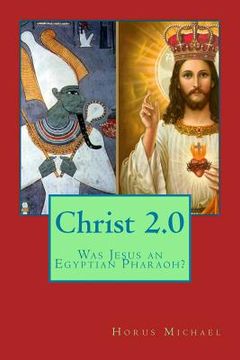Reseña del libro "Christ 2.0: Was Jesus an Egyptian Pharaoh? (en Inglés)"
Christ 2.0: by Horus Michael ============================ An analysis and comparison of Biblical information with Ancient Egyptian source material. Contains original research by the Author. ============================ (Excerpt): On December 25 during the reign of Caesar, the soul of AmonRa impregnated a virgin woman named Mary and she gave birth to Christ. Though, the woman may have been a Priestess of Vesta, or a Vestal Virgin, a sacred woman in Rome. Vestals could not be pregnant as this violated the Roman Laws, because Vestals were required to be Chaste and Pure. Wise men from the East saw the Star of Christ's birth and went looking for it, said to number 3. If so, the 3 Wise Men - called the Three Kings - were actually the 3 Kings of the Pyramids of Giza, Egypt because the 3 Pyramids are in the night sky as Orion's Belt. The star appeared in the Constellation Virgo, the Virgin, appearing over a Manger. On Earth this meant within a Mastaba, or trapezoid shaped tomb in Egypt following the line from the 3 Pyramids. This line led to Saqqara to the Mastaba of Shepseskaf, of the 4th Dynasty. A Mastaba resembles a Manger. The new born Christ was named after (Djed-ka-Ra) Isesi, a King whose Pyramid was nearby the Mastaba in Saqqara. His original name was revealed in a vision as being Immanuel. In Roman (Latin) the name was spelled Iesus. In Greek it is JESUS. The Greek word for "burial in a tomb" was Christ, from the Egyptian word QRST or KRST, as a Mastaba is a tomb. So the child was later to be known as JESUS the Christ. Inside the Mastaba tomb were burial offerings for the dead Pharaoh Shepseskaf, in the form of Gold, Frankincense and Myrrh. The Pharaoh Isesi of the 5th Dynasty once raided the nations of Punt for Myrrh and Nubia for gold. He also raided Canaan. Jesus was born in Bethlehem, which meant "House of Bread" in Hebrew & Aramaic. The House of Bread in Egypt was the word for Offerings Chamber in the tomb. It is also a city in Judea. When the Julian Calendar was converted to the Christian Calendar, the birth of Christ was moved from Summer Solstice to Winter Solstice and the 5 Epagomenal Days added in the Julian/Egyptian Calendar - the 5 birthdays of the Gods - occurs after the Solstice with Christ's birthday on Dec 25, which is the birthday of Nephthys (Osiris, Horus, Set, Isis (Aset), and Nephthys). So Christianity preserves Ancient Egyptian Knowledge in religion. Copyright 2016 Horus Michael, All rights reserved.

